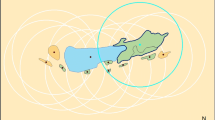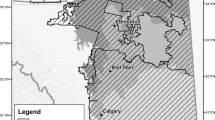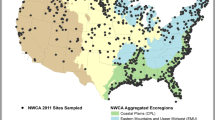Abstract
RecentAbstract. Recent approaches to wetland assessment have advocated a multilevel approach which incorporates assessments based on landscape (remote sensing) data, on-site but “rapid” methods, and intensive methods where quantitative data is collected. Brown and Vivas (2004) recently pro- posed an assessment method that uses remote sensing information (Landscape Development Index or LDI) and propose that it may also be usable as a quantified human disturbance gradient. The LDI was evaluated using a large reference wetland data set from Ohio using land use percentages within a 1 km radius circle of the wetlands. The LDI had interpretable and significant relationships with another human disturbance gradient (the Ohio Rapid Assessment Method for Wetlands or ORAM) and with most metrics and scores from the Vegetation Index of Biotic Integrity (VIBI) developed for use in the State of Ohio. Metrics from emergent wetlands had the most significant correlations with the LDI (10 of 10 metrics), followed by forested wetlands (8 of 10 metrics) and shrub wetlands (4 of 10). Poor correlation for VIBI scores and metrics of shrub wetlands was due to differences in attainable LDI scores based on ecoregion and natural buffers shielding the wetland from otherwise intensive land uses. The ORAM and VIBI were developed for use in wetlands in Ohio completely independent of the LDI. It is an important test of the LDI concept that so many interpretable and significant relationships occurred between the VIBI scores, VIBI metric values, and the ORAM scores. For the purposes of VIBI development, the LDI is an independent, quantified disturbance gradient that has provided an additional test of the VIBI. Given its theoretical underpinnings and the fact that it uses quantified land use percentages, the LDI has many advantages over more qualita- tive human disturbance gradients. Using land use percentages from increasingly smaller distances from the wetland edge (100-200 m) may improve the resolution of the LDI to detect on-site dis-turbances to a wetland which degrade its ecological condition. The LDI should be evaluated with other large reference data sets in other regions to evaluate its validity and usefulness as an assessment tool.
Similar content being viewed by others
References
Brooks, R. P., Heller-Wardrop, D. and Perot, J. K.: 1999, ‘Development and application of assessment protocols for determining the ecological condition of wetlands in the Juniata River watershed’, Technical Report, EPA/600/R-98/181, U.S. Environmental Protection Agency, Western Division, National Health and Environmental Effects Laboratory, Corvallis, Oregon.
Brooks, R. P., Heller-Wardrop, D. and Bishop, J. A.: 2004, ‘Assessing wetland condition on a watershed basis in the Mid-Atlantic region using synoptic land cover maps’, Environ. Monit. Assess. 94, 9–22.
Brown, M. T. and Vivas, M. B.: 2004, ‘Landscape Development Intensity Index. Environ. Monit. Assess. xxx, 1–21.
ESRI: 1999, ‘ArcView GIS v. 3.2’, Environmental System Research Institute, Redlands, CA.
Fennessy, M. S., Gray, M. A. and Lopez, R. D.: 1998a, ‘An ecological assessment of wetlands using reference sites, Volume 1’, Technical Report, Ohio Environmental Protection Agency, Division of Surface Water, Columbus, Ohio.
Fennessy, M. S., Geho, R., Elfritz, B. and Lopez, R.: 1998b, ‘Testing the floristic quality assessment index as an indicator of riparian wetland disturbance’, Technical Report, Ohio Environmental Protection Agency, Division of Surface Water, Columbus, Ohio.
Fennessy, M. S., Gernes, M., Mack, J., Wardrop, D.: 2002, ‘Methods for evaluating wetland condition: Using vegetation to assess environmental conditions in wetlands’, Technical Report, EPA-822-R-02-020, Office of Water, U.S. Environmental Protection Agency, Washington, D.C.
Fennessy, M. S., Rokosch, A. and Mack, J. J.: 2004, ‘Integrated wetland assessment program. Part 5: biogeochemical and hydrological investigations of natural and mitigation wetlands’, Ohio EPA Technical Report WET/2004-5, Ohio Environmental Protection Agency, Wetland Ecology Group, Division of Surface Water, Columbus, Ohio.
Karr, J. R. and Chu, E. W.: 1999, Restoring life in Running Waters: Better Biological Monitoring, Island Press, Washington, D.C.
Mack, J. J., Micacchion, M., Augusta, L. D. and Sablak, G. R.: 2000, ‘Vegetation indices of biotic integrity (VIBI) for wetlands and calibration of the Ohio rapid assessment method for wetlands v. 5.0’, Technical Report, Ohio Environmental Protection Agency, Division of Surface Water, Wetland Ecology Group, Columbus, Ohio.
Mack, J. J.: 2001a, ‘Ohio rapid assessment method for wetlands v. 5.0, user's manual and scoring forms’, Ohio EPA Technical Report WET/2001-1, Ohio Environmental Protection Agency, Division of Surface Water, Wetland Ecology Group, Columbus, Ohio.
Mack, J. J.: 2001b, ‘Vegetation indices of biotic integrity (VIBI) for wetlands: Ecoregional, hydrogeomorphic, and plant community comparison with preliminary wetland aquatic life use designations’, Technical Report, Ohio Environmental Protection Agency, Division of Surface Water, Wetland Ecology Group, Columbus, Ohio.
Mack, J. J.: 2004a, ‘Integrated wetland assessment program. Part 2: An ordination and classification of wetlands in the till and lake plains and allegheny Plateau regions’ Ohio EPA Technical Report WET/2004-2. Ohio Environmental Protection Agency, Wetland Ecology Group, Division of Surface Water, Columbus, Ohio.
Mack, J. J.: 2004b, ‘Integrated wetland assessment program. Part 4: Vegetation index of biotic integrity (VIBI) and tiered aquatic life uses (TALUs) for Ohio wetlands’, Ohio EPA Technical Report WET/2004-4, Ohio Environmental Protection Agency, Wetland Ecology Group, Division of Surface Water, Columbus, Ohio.
Mack, J. J.: 2004c, ‘Integrated wetland assessment program. Part 9: field manual for the vegetation index of biotic integrity for wetlands v. 1.3’, Ohio EPA Technical Report, WET/2004-9, Ohio Environmental Protection Agency, Wetland Ecology Group, Division of Surface Water, Columbus, Ohio.
Odum, H. T.: 1996, Environmental Accounting: Emergy and Environmental Decision Making, John Wiley & Sons, New York, New York.
Peet, R. K., Wentworth, T. R. and White, P. S.: 1998, ‘A flexible, multipurpose method for recording vegetation composition and structure’, Castanea 63, 262–274.
Teels, B. and Adamus, P. R.: 2002, ‘Methods for evaluating wetland condition: Developing metrics and indexes of biotic integrity’ Technical Report, EPA-822-R-02-016, Office of Water, U.S. Environmental Protection Agency, Washington, D.C.
Vogelmann, J. E., Howard, S. M., Yang, L., Larson, C. R., Wylie, B. K. and Van Driel, N.: 2001, ‘Completion of the 1990s national land cover data set for the conterminous United States from Landsat thematic mapper data and ancillary data sources’, Photogrammetric Engineering and Remote Sensing, 67, 650–652.
Thomson, J. D., Weiblen, G. Thomson, B. A. Alfaro, S. and Legendre, P.: 1996, ‘Untangling multiple factors in spatial distributions: lilies, gophers, and rocks’, Ecology, 77, 1698–1715.
Author information
Authors and Affiliations
Rights and permissions
About this article
Cite this article
Mack, J.J. Landscape as a predictor of wetland condition: an evaluation of the Landscape Development Index (LDI) with a large reference wetland dataset from Ohio. Environ Monit Assess 120, 221–241 (2006). https://doi.org/10.1007/s10661-005-9058-8
Received:
Accepted:
Published:
Issue Date:
DOI: https://doi.org/10.1007/s10661-005-9058-8




